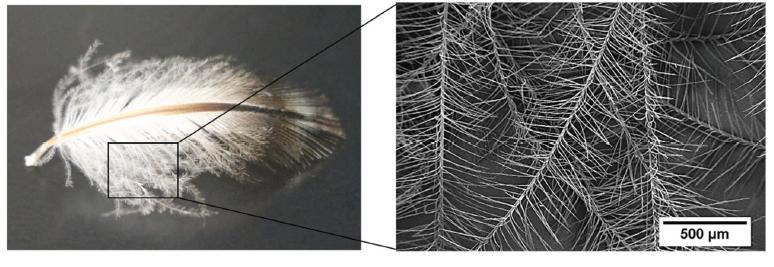企鹅能够在寒冷的地方生存并一代代繁殖,除了自身脂肪的保暖作用,它们的羽毛,也是功不可没的!企鹅通常有一层羽毛,一层绒毛。企鹅羽毛的根很硬且较短,在体表整齐地排列成鳞片状,防止外界冷空气的进入;内层纤细的绒毛又防止了内部热量的流失。这种双层结构就像我们穿了一层保暖内衣+羽绒服,既能抵御大风的袭击,又保护了皮肤免受冰尖的刺伤。在层次结构材料中,具有企鹅绒毛状形态的人造介孔、纳米纤维具有独特的性能,因此具有广泛的应用前景。

Figure 1.a) Photograph of a Humboldt penguin (Spheniscus humboldti) feather (left), and corresponding scanning electron microscopy (SEM) image (right) of the downy lower barbs of the feather.
近日,德国拜罗伊特大学Andreas Greiner教授团队采用同轴电纺(自上而下法)和三酰胺纤维自组装法(自底向上法)得到了具有企鹅羽毛绒毛状纤维形态和独特性能的介孔纳米纤维基非织造布。用于过滤0.3μm气溶胶粒子时,过滤效率高达99.8%,与电纺聚苯乙烯(过滤效率约为52.6%)相比,该研究制备电纺非织造布的过滤效率得到显著提高。此外,高过滤效率通常需要较高的能源消耗和压降损失。但是,在本研究的过滤试验中观察到,过滤过程中并没有导致压降损失和能量消耗,这主要归因于电纺非织造布的特殊介孔结构,以及较大的BTA纤维密度。因此,利用具有超分子原纤维的电纺支化纤维为构建新型介孔结构非织造布提供了新方法,这种新型非织造布具有独特的形态、性能特征,在过滤、催化和储能等方面具有潜在的应用前景。相关研究成果以“Mesostructured Nonwovens with Penguin Downy Feather-Like Morphology—Top-Down Combined with Bottom-Up”为题目发表于期刊《Adv. Funct. Mater.》上。

Figure 2 Illustration of the process steps for preparing mesostructured composite nonwovens.

Figure 3 Optical microscopy images (from left to right) of non-seeded BTA fibrils grown on a glass slide, non-seeded BTA fibrils grown on a glass slide with electrospun neat PS fibers (the blue arrows indicatethe locations of PS fibers) and mesostructured nonwoven with S0.2G0.3 fibers with seeded BTA fibrils grown from PS fiber’s surface.
